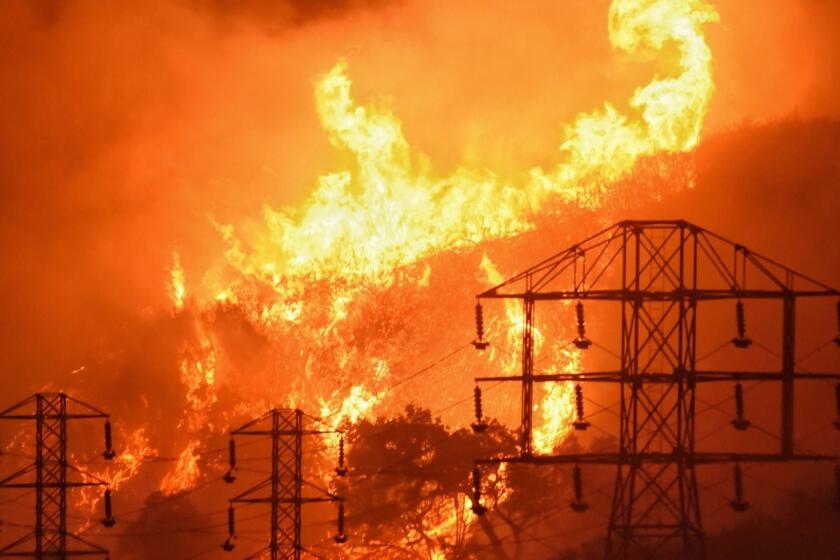Southern California Edison agrees to $550 million in fines for role in 5 wildfires

- Share via
Southern California Edison faces more than half a billion dollars in fines and penalties for its role in five devastating wildfires in 2017 and 2018, officials announced this week.
The California Public Utilities Commission approved the settlement agreement with the utility during a meeting Thursday. The agreement includes fines and penalties relating to the Thomas, Woolsey, Rye, Meyers and Liberty fires, which collectively burned more than 380,000 acres and destroyed thousands of homes.
Investigators with the commission’s Safety and Enforcement Division determined that Southern California Edison violated state safety regulations that govern the design, construction and maintenance of overhead electrical lines and communication facilities, which led to the ignition of the blazes, they said.
Under the agreement, the utility’s shareholders will pay a $110-million penalty to California’s general fund and contribute $65 million toward improved safety measures.
The agreement also prevents Southern California Edison from tapping ratepayers to cover $375 million in cost recoveries stemming from insurance claims relating to the fires.
“Thomas and Woolsey, by any definition, were catastrophic, but all five of them impacted communities, families, local governments and health and safety personnel,” Commissioner Clifford Rechtschaffen said during the meeting. “We can’t and should not minimize the great hardship and suffering that resulted from these fires, and from Edison’s violations.”
Investigators have determined that Southern California Edison power lines ignited the 2017 Thomas fire, a massive blaze in Ventura and Santa Barbara counties that killed two people and later gave rise to a massive mudflow that resulted in at least 21 deaths.
Southern California Edison spokeswoman Gabriela Ornelas on Friday described the settlement as “fair and reasonable,” and said signing the agreement was not an admission of fault. The utility serves 15 million customers across a 50,000-square mile service territory.
The agreement “puts one additional uncertainty behind us as the utility continues to implement its comprehensive wildfire risk mitigation measures,” she said, citing grid hardening, increased circuit segmentation, covered conductors, insulated wires and more precise public safety power shutoffs as examples of those measures.
Experts have said California’s wildfires are growing increasingly large and destructive due to climate change and worsening drought. According to the California Department of Forestry and Fire Protection, electrical equipment was responsible for 10% of the state’s blazes in 2019, the most recent year for which there was data.
Public Utilities Commission investigators said the Thomas fire, which ignited in December 2017, was sparked after Southern California Edison power lines came into contact with one another in what is known as a “line slap,” which creates an electrical arc that deposits hot, burning or molten material into a receptive fuel bed.
The fire seared through more than 280,000 acres, damaged more than 1,300 structures and caused two deaths in Santa Barbara and Ventura counties. It was the largest wildfire in California history at the time.
In January 2018, the Thomas fire’s burn scar also contributed to debris flows that resulted in 23 additional deaths and hundreds more structures damaged or destroyed.
“Our thoughts continue to be with the families and businesses who have been affected by wildfires,” Ornelas said.
Southern California Edison has also acknowledged that its equipment was likely “associated” with 2018’s deadly Woolsey fire, which burned more than 1,600 structures in Los Angeles and Ventura counties and killed three people.
Earlier this year, the California Department of Justice determined that Edison would not face criminal charges for its role in that blaze. It is considered the eighth-most destructive wildfire in California history.
The three other fires outlined in the agreement — the Rye fire in Santa Clarita, the Liberty fire in Murrieta and the Meyers fire in San Bernardino — all occurred in December 2017. Together they burned about 6,400 acres.
In a quarterly earnings report, Southern California Edison revealed information about the role its utility lines may have played in the Woolsey fire.
The Public Utilities Commission said Thursday’s settlement was reached under a new enforcement tool called an administrative consent order, which was created in November 2020 as an alternative to more a formal investigation process known as an order instituting investigation.
The regulatory agency’s five-member committee approved the settlement agreement on a 4-1 vote, with Commissioner Darcie Houck voting in opposition, expressing hesitation about the new tool and a desire for more time and community involvement.
“The commission has the option to pursue an order instituting investigation in this instance, which would provide greater transparency than the administrative consent order resolution,” she said during the meeting. “These fires occurred four years ago, so there’s no reason to rush through a settlement.”
Some stakeholders expressed similar concerns.
“One of our issues is that we can’t say whether this is an appropriate penalty because we haven’t had the opportunity to be in the room and understand how they got there,” Katy Morsony, staff attorney for the Utility Reform Network, or TURN, said Friday.
TURN, a consumer watchdog group, issued a letter of opposition to the initial draft of the agreement released in November. Morsoney said that although improvements had been made, the group was not convinced that the approved resolution was ideal.
“For catastrophic events of this sort, it’s only proper to have a more full process,” she said.
In a statement about the decision, the Public Utilities Commission said the new tool aligned its practices with those of other state and local enforcement agencies, and was intended to “better serve Californians through streamlined enforcement actions.”
This month, the commission reached a similar agreement with Pacific Gas & Electric Co., which was charged for its role in the Kincade fire. That fire tore through more than 77,000 acres of Northern California wine country in 2019.
More to Read
Sign up for Essential California
The most important California stories and recommendations in your inbox every morning.
You may occasionally receive promotional content from the Los Angeles Times.














